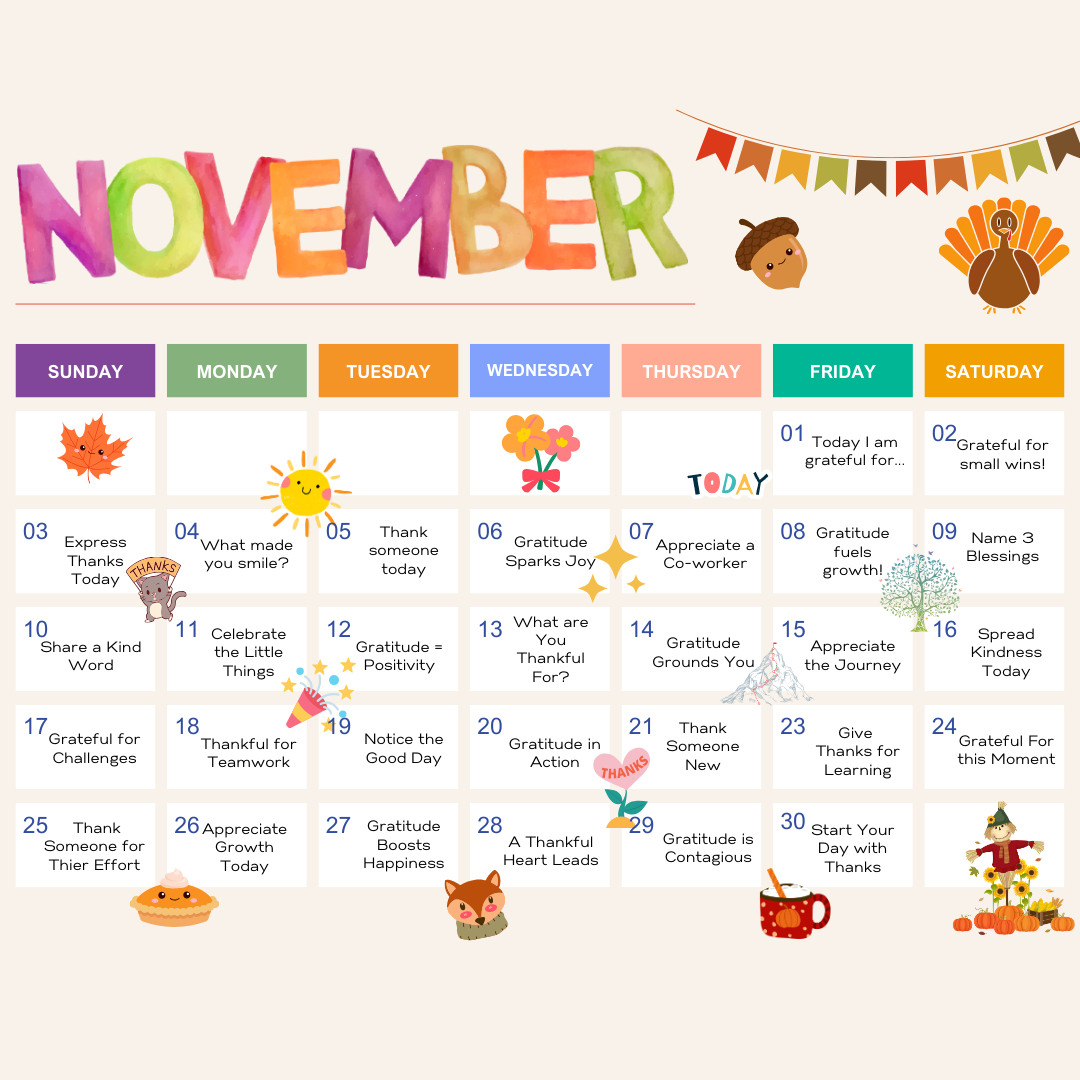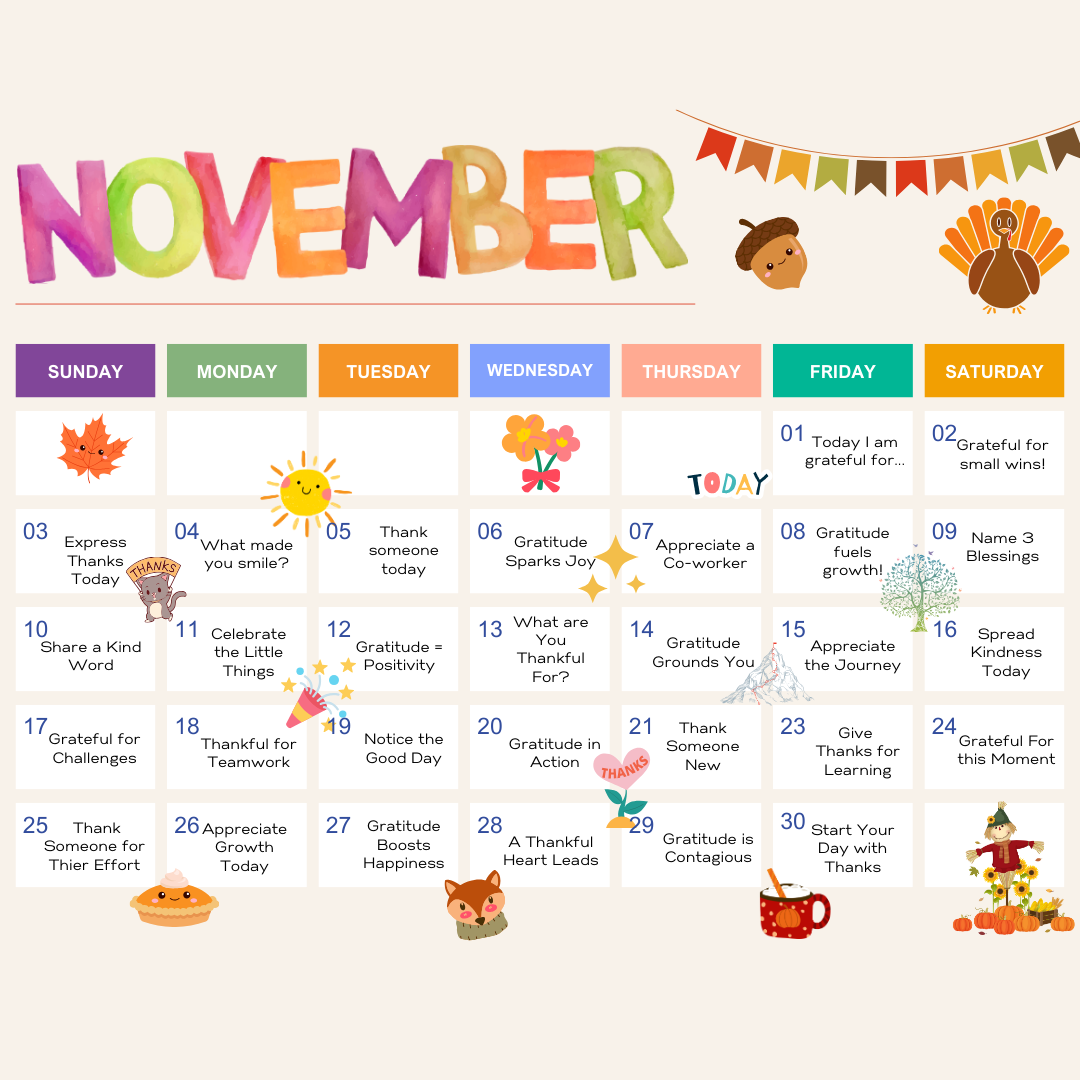The Power of Gratitude: How a Grateful Heart Transforms Workplaces and Lives
Gratitude in the Workplace
Deadlines, meetings, and targets, it's easy to get caught up in the hustle and forget one of the most powerful tools we have to improve both our personal and professional lives: gratitude.
But what if I told you that this simple practice could transform not only your mindset but your entire workplace culture? From boosting employee morale to improving physical and mental health, gratitude is a game-changer that many overlook.
November, the month of Thanksgiving in the United States, is the perfect time to focus on the power of gratitude. This month, we're dedicating our team calendar to gratitude with daily prompts that inspire thankfulness.
In this post, we'll explore why gratitude is so powerful and how you can harness it to elevate your workplace—and your life.
Use this calendar to support your team! Learn more about what a corporate wellness consultant does!
Gratitude in the Workplace
What Is Gratitude?
Before we dive into the benefits, let's define what gratitude actually is. Gratitude is the act of recognizing and appreciating the good things in life, whether they are big or small.
It's not just a fleeting feeling; it's a mindset that can be cultivated through practice. Being grateful doesn't mean ignoring challenges or difficulties, but rather, it’s about shifting your focus toward the positives and appreciating the efforts of others.
Science Behind Gratitude
The Science Behind Gratitude
It might surprise you, but gratitude isn't just a feel-good emotion; it's scientifically proven to have numerous benefits.
Researchers have shown that practicing gratitude can improve your mental and physical health, strengthen relationships, and even enhance your performance at work.
A study conducted by the Greater Good Science Center found that people who regularly practice gratitude report fewer symptoms of illness, more optimism, and greater satisfaction with their lives.
Other studies have found that grateful people tend to sleep better, exercise more, and experience lower levels of stress.
But why does gratitude have such far-reaching effects? One reason is that gratitude shifts your focus. Instead of dwelling on what you lack, you begin to focus on the abundance already present in your life.
This mental shift can trigger a cascade of positive emotions that uplift your overall well-being. More articles on mental health and wellness for your team.
Gratitude in the Workplace
Gratitude in the Workplace
If you're wondering how gratitude translates into a corporate environment, think about it this way: a team that's grateful is a team that thrives. Cultivating a culture of gratitude at work isn't just about saying "thank you" more often (though that’s a great start). It’s about fostering a mindset where appreciation becomes second nature and where employees feel valued.
Let’s break down how gratitude can enhance key aspects of the workplace:
1. Boosts Employee Engagement
Disengaged employees are one of the biggest challenges companies face today. But when employees feel appreciated, their level of engagement skyrockets. Simple acts like recognizing a colleague's hard work or expressing thanks for a team member’s effort can build stronger connections, which naturally leads to higher engagement.
Engaged employees are not only more productive but also more committed to their roles. When workers feel valued, they’re more likely to go the extra mile, stay with the company longer, and contribute to a positive work culture.
2. Improves Team Collaboration
Gratitude has a contagious effect. When one person expresses thanks, it creates a ripple effect that can spread throughout the team. As people feel appreciated, they are more inclined to help others, leading to improved teamwork and collaboration.
Imagine a workplace where gratitude is at the forefront—where team members regularly acknowledge each other’s contributions. This creates an environment where employees feel safe to share ideas, support each other, and tackle challenges together.
3. Reduces Stress and Burnout
Workplace stress and burnout are at an all-time high, especially as remote work blurs the lines between professional and personal life. But gratitude has a unique way of reducing stress levels. When we focus on what we’re thankful for, our brain releases dopamine and serotonin—two neurotransmitters responsible for making us feel good. This shift in perspective can counterbalance the pressures and stresses of work.
Gratitude can also increase emotional resilience. When employees practice gratitude, they are better equipped to handle setbacks and frustrations, leading to a healthier work-life balance and less burnout.
4. Strengthens Leadership
Gratitude and leadership go hand-in-hand. Leaders who consistently express gratitude are more likely to inspire loyalty and respect from their teams. Acknowledging the efforts of employees fosters a sense of belonging and trust. It also sets the tone for a positive and supportive work environment.
Grateful leaders create an atmosphere where feedback is constructive, and team members feel motivated to contribute. By appreciating the strengths and efforts of your employees, you empower them to continue growing and performing at their best.
Incorporate gratitude in the workplace
How to Incorporate Gratitude in the Workplace
Now that we’ve established the importance of gratitude, how can you start integrating it into your workplace?
Here are some practical steps you can take:
1. Start with Daily Gratitude Practices
Encourage your team to make gratitude part of their daily routine. Whether it's starting meetings with a round of thanks or sending out a weekly email highlighting team achievements, small acts of appreciation go a long way. Consider using our daily prompts for November as a way to keep gratitude top of mind.
2. Create a Gratitude Wall
A simple but effective idea is to create a "Gratitude Wall" in your office or virtual workspace.
Team members can post notes of thanks and appreciation for their colleagues. Over time, this wall will become a visual representation of the positive energy flowing through your team.
3. Host Gratitude-Focused Team Building Activities
Team building doesn't always have to be about trust falls and icebreakers. Try incorporating activities that promote gratitude.
For example, host a "Thankful Thursday" where everyone shares one thing they appreciate about a coworker. Or, try a gratitude circle where team members exchange words of thanks in a structured format.
4. Incorporate Gratitude into Performance Reviews
Incorporating gratitude into formal processes like performance reviews can have a lasting impact. Instead of focusing solely on areas of improvement, balance feedback with recognition and thanks for what employees have done well. This approach can help employees feel more motivated and appreciated. Learn more about rewards and recognition for your teams!
5. Lead by Example
As with any cultural shift, it starts from the top. Leaders who regularly express gratitude set the tone for the rest of the team.
Whether it’s a quick thank-you note, verbal recognition, or public acknowledgment during meetings, your team will follow your lead. Leadership in the workplace!
Gratitude and YOU Personally
How Gratitude Benefits You Personally
Gratitude isn't just a tool for improving the workplace—it also has profound effects on your personal well-being. By practicing gratitude, you become more attuned to the positives in your life. This can lead to:
Improved Mental Health:
Regular gratitude practices have been shown to reduce symptoms of depression and anxiety.
Better Sleep:
People who keep a gratitude journal or practice thankfulness before bed tend to fall asleep faster and experience higher-quality sleep.
Stronger Relationships:
Gratitude fosters connection. When you express thanks in your personal relationships, you deepen those bonds and strengthen emotional ties.
Cultivate Gratitude
Cultivating Gratitude in Everyday Life
Want to bring gratitude into your personal life as well? Here are some simple practices:
Gratitude Journaling:
Each day, write down three things you're thankful for. This can shift your mindset over time and train your brain to focus on the positives.
Gratitude Meditation:
Spend a few minutes each day reflecting on the things you're grateful for. This can help center your mind and relieve stress.
Verbal Expressions of Gratitude:
Make it a habit to verbally thank people—whether it’s your family, friends, or the barista at your local coffee shop.
Final Thoughts: Gratitude as a Superpower
Gratitude is much more than just a warm, fuzzy feeling. It’s a powerful tool that can improve workplace culture, strengthen relationships, and enhance personal well-being.
By practicing and promoting gratitude, you create an environment where people feel valued, connected, and motivated.
So, this November, let’s commit to bringing more gratitude into our lives and workplaces. After all, as we express our thankfulness, we not only uplift others but also elevate ourselves.
In the words of William Arthur Ward:
"Feeling gratitude and not expressing it is like wrapping a present and not giving it."
Let’s unwrap those gifts and share them with the world.
Let’s Get Grateful!
Ready to start your gratitude journey? Use our daily gratitude prompts throughout November to inspire yourself and your team. You’ll be amazed at how this simple practice can transform your life—one thankful thought at a time!
Kathie Owen
About the Author:
Kathie Owen is a seasoned Corporate Wellness Professional with over a decade of experience driving wellness initiatives.
With a rich background as a certified fitness trainer and life coach since 2002, Kathie combines her practical expertise in health and wellness with a deep understanding of psychological principles, thanks to her degree in Psychology.
Her holistic approach to corporate wellness not only fosters a culture of health and engagement among employees but also supports organizations in achieving their most ambitious wellness goals.
Kathie's Coaching and Consulting reflects her passion for empowering corporate executives to create thriving workplace environments through strategic wellness programs and employee engagement. Kathie’s Bio is Here!



















Discover why high-achievers wake up at 3AM and how to fix it. It's not insomnia—it's mental "open loops" craving closure. Learn the 6-step Evening Wind-Down Checklist to signal safety to your nervous system and finally get deep, restorative sleep without supplements. Your performance depends on recovery, not just hustle. #executivewellness #sleepquality #highperformance #nervoussystem #3AMwakeups